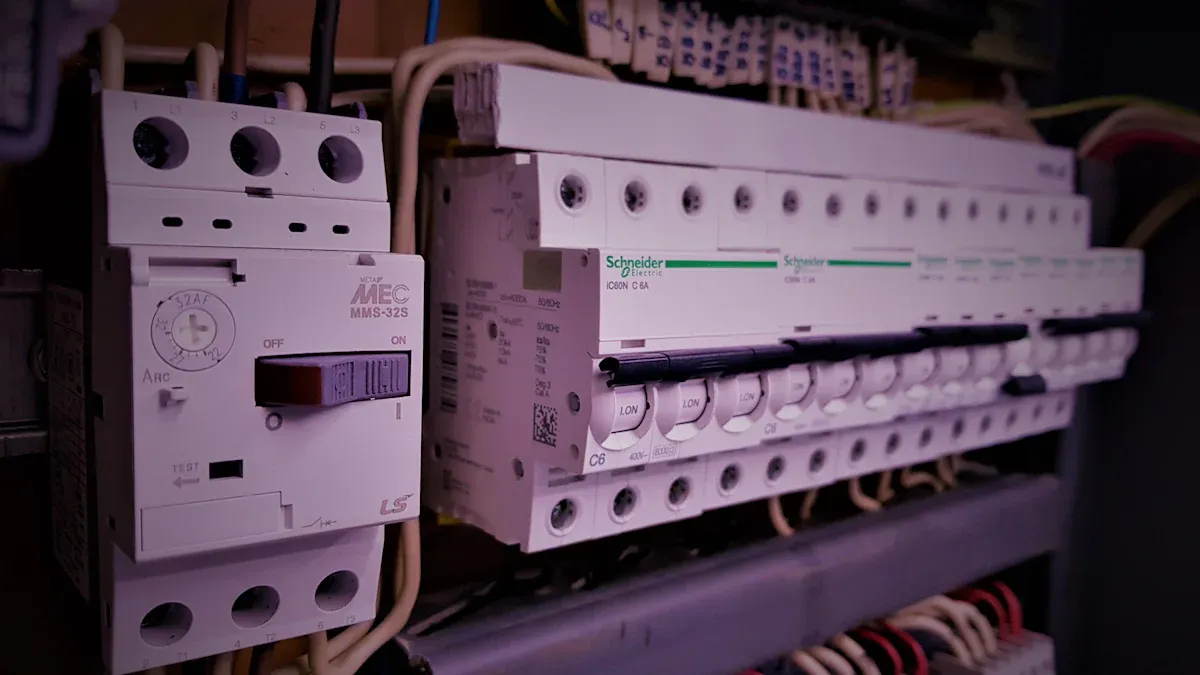
A faulty freezer defrost heater can cause more trouble than you might think. Frost buildup, uneven cooling, and food spoilage are just a few problems it brings. Addressing these issues quickly keeps your freezer running efficiently and your food fresh. Ignoring them could lead to costly repairs or even a complete breakdown.
Key Takeaways
- Check your freezer often for frost on the coils. Frost might mean the defrost heater is broken and needs fixing fast to keep food safe.
- Make sure the defrost drain stays unclogged to stop leaks. Cleaning it regularly helps water flow out properly.
- Get your freezer checked by a professional once a year. This can find problems early and make your freezer last longer.
Symptoms of Freezer Defrost Heater Problems

Frost Accumulation on Evaporator Coils
One of the most common signs of a problem with the freezer defrost heater is frost buildup on the evaporator coils. These coils are responsible for cooling the air inside the freezer. When the defrost heater fails, it can no longer melt the frost that naturally forms during operation. Over time, this frost thickens and restricts airflow, making it harder for the freezer to maintain the right temperature. If you notice a layer of frost covering the coils, it’s a clear indication that the defrost system isn’t working as it should.
Uneven Freezer Temperatures
Uneven temperatures inside the freezer can also point to defrost heater issues. For example, some areas might feel colder than others, while certain spots may not freeze at all. This happens because frost buildup on the evaporator coils disrupts the airflow needed to evenly distribute cold air. Additionally, a malfunctioning evaporator fan or thermostat can worsen the problem. When the fan stops working, it prevents proper cooling, leading to ice buildup and defrost system failure. A faulty thermostat can further increase temperature fluctuations, making it difficult for the freezer to maintain a consistent environment.
Water Leaks Inside the Freezer
Water pooling at the bottom of the freezer is another symptom to watch for. The defrost system periodically activates a heating element to melt frost on the evaporator. This melted frost is supposed to drain through a tube. However, if the drain tube becomes clogged, water has nowhere to go and starts accumulating inside the freezer. Over time, this can lead to noticeable leaks. Regular maintenance, like cleaning the defrost drain, can help prevent this issue. Keeping the drain clear ensures water flows properly and reduces the risk of leaks caused by defrost heater malfunctions.
Continuous Freezer Operation or Strange Noises
When the freezer defrost heater isn’t working, the appliance may run continuously in an attempt to maintain the desired temperature. This constant operation not only wastes energy but also puts extra strain on the freezer’s components. You might also hear unusual noises, such as clicking or buzzing, which could indicate that the defrost timer or other parts of the system are struggling to function. These signs shouldn’t be ignored, as they often signal a deeper issue with the defrost system that needs immediate attention.
Troubleshooting Freezer Defrost Heater Issues
Inspecting the Defrost Heater for Physical Damage
Before diving into complex diagnostics, start with a simple visual inspection. Look for any obvious signs of damage to the defrost heater, such as burnt spots, broken wires, or corrosion. These physical issues often indicate why the heater isn’t functioning properly.
Here’s a step-by-step guide to help you inspect the defrost heater effectively:
| Step | Description |
|---|---|
| Safety Precautions | Turn off the freezer’s power supply, consult the service manual, and wear protective gear. |
| Visual Inspection | Examine the defrost heater, wiring, and sensors for visible damage or wear. |
| Test Control Circuit | Use a multimeter to measure voltage and resistance, ensuring proper operation. |
| Monitor Cycle | Observe the defrost cycle and listen for unusual sounds during operation. |
| Evaluate Performance | Check the accuracy of sensors and the overall condition of the heater. |
| Review Fault Codes | Decode any error codes on the control board and document findings. |
| Consult Documentation | Refer to the service manual or contact technical support if needed. |
Tip: Always prioritize safety when working with electrical components. Turning off the power supply is non-negotiable.
Testing the Defrost Thermostat for Continuity
The defrost thermostat plays a crucial role in regulating the defrost cycle. If it’s faulty, the freezer may not defrost properly. To test it, you’ll need a multimeter. Set the multimeter to the continuity setting, then connect its probes to the thermostat terminals. If the thermostat is functioning, the multimeter will emit a beep or show a reading indicating continuity.
If there’s no continuity, the thermostat likely needs replacement. A defective thermostat can disrupt the entire defrost system, so addressing this issue promptly is essential.
Note: Perform this test when the thermostat is at a low temperature, as it only shows continuity when it’s cold.
Checking the Defrost Timer Functionality
The defrost timer controls when the defrost cycle starts and stops. If it malfunctions, the freezer may either over-defrost or fail to defrost altogether. To check the timer, manually advance it using a screwdriver. Listen for a click, which signals the heater’s activation.
If the heater doesn’t turn on, the timer might be faulty. In such cases, replacing the timer is often the best solution. A properly functioning defrost timer ensures the freezer maintains optimal performance without wasting energy.
Using a Multimeter to Test the Heater’s Electrical Continuity
A multimeter is an invaluable tool for diagnosing electrical issues in the defrost heater. To test for continuity:
- Set the multimeter to the Ω (ohms) setting.
- Connect one probe to the multimeter port labeled Ω and the other to the COM port.
- Place the probes on the heater’s terminals.
If the multimeter beeps or shows a resistance reading, the heater has continuity and is likely functional. However, if the reading shows infinity, the heater may have an internal break or fault.
When testing multiple terminal pairs, at least one pair should show continuity. If none do, or if a previously functional pair now shows infinity, the defrost heater may need replacement.
Pro Tip: If the heater shows continuity but the freezer still has issues, the problem might lie with the electronic control board or thermistor.
Fixes for Freezer Defrost Heater Problems
Replacing a Malfunctioning Defrost Heater
When the defrost heater stops working, replacing it is often the best solution. Start by disconnecting the freezer from the power source to ensure safety. Locate the defrost heater, which is usually near the evaporator coils, and carefully remove it. Install a new heater that matches your freezer model. This straightforward fix can resolve issues like frost buildup and uneven cooling.
Tip: Always consult the freezer’s manual to find the correct replacement part and installation steps.
Replacing the defrost heater is a reliable way to restore the freezer’s efficiency. Consumer reviews often highlight how this fix eliminates frost accumulation and improves temperature consistency.
Repairing or Replacing a Faulty Defrost Thermostat
A faulty defrost thermostat can disrupt the entire defrost cycle. Repairing or replacing it depends on the extent of the damage. If the thermostat is only slightly damaged, repairing it can save money and reduce waste. However, if it’s beyond repair, replacing it is the better option.
- Cost Savings: Repairs are usually cheaper than buying a new freezer.
- Environmental Impact: Fixing the thermostat reduces waste and carbon emissions.
- Aesthetic Considerations: Keeping the existing freezer maintains the kitchen’s visual harmony.
Whether you repair or replace the thermostat, addressing the issue promptly ensures the freezer operates efficiently.
Resetting or Replacing the Defrost Timer
The defrost timer plays a critical role in managing the freezer’s cooling cycle. If it malfunctions, resetting it might solve the problem. To reset, manually advance the timer using a screwdriver until you hear a click. If resetting doesn’t work, replacing the timer is necessary.
Modern defrost timers, especially adaptive control boards, optimize energy use by initiating defrost cycles based on actual temperature conditions. This prevents ice buildup and enhances cooling performance. By ensuring the defrost timer functions correctly, you can maintain the freezer’s efficiency and avoid costly repairs.
Seeking Professional Assistance for Complex Repairs
Some freezer defrost heater problems require professional expertise. If replacing components or troubleshooting doesn’t resolve the issue, it’s time to call a technician. Professionals have the tools and knowledge to diagnose and fix complex problems, such as issues with the electronic control board or wiring.
Note: Attempting advanced repairs without proper training can cause further damage. It’s safer to rely on a professional for intricate fixes.
Investing in professional assistance ensures the freezer remains in top condition and prevents recurring issues.
Preventive Maintenance for Freezer Defrost Heater

Cleaning the Freezer Regularly
Keeping the freezer clean is one of the simplest ways to maintain its efficiency. Dust and grime can accumulate on the condenser coils, reducing performance by as much as 30%. Regular cleaning prevents this. Use a soft brush or vacuum to remove dirt from the coils every few months. Don’t forget the door seals. Wipe them down monthly with a mild soap solution to keep them flexible and effective. A quick dollar bill test can help check the seal’s integrity. Close the freezer door on a bill and see if it slides out easily. If it does, the seal might need cleaning or replacement.
Inspecting and Replacing Worn Components
Worn-out parts can lead to bigger problems if left unchecked. Inspect the defrost heater, thermostat, and timer regularly for signs of wear or damage. Look for cracks, corrosion, or loose connections. Replace any faulty components promptly to avoid system failures. For example, a damaged defrost heater can cause frost buildup, leading to uneven cooling. Staying proactive with inspections ensures the freezer runs smoothly and extends its lifespan.
Avoiding Overloading the Freezer
Overloading the freezer can strain its components and reduce airflow. This makes it harder for the freezer to maintain consistent temperatures. Leave some space between items to allow air to circulate freely. Avoid stacking food too high or blocking vents. A well-organized freezer not only works more efficiently but also makes it easier to find what you need.
Scheduling Routine Maintenance Checks
Routine maintenance checks are essential for catching potential issues early. Schedule a professional inspection at least once a year. Technicians can test the freezer defrost heater, thermostat, and other critical parts to ensure they’re functioning properly. They can also clean hard-to-reach areas and provide tips for better performance. Regular check-ups save money in the long run by preventing costly repairs and extending the freezer’s life.
Tip: Keep a maintenance log to track cleaning schedules and inspections. This helps you stay on top of preventive care and ensures nothing gets overlooked.
Fixing freezer defrost heater problems quickly keeps your freezer efficient and your food safe. Troubleshooting and repairs prevent frost buildup, uneven cooling, and leaks. Regular maintenance, like cleaning and inspections, avoids future issues. Acting early saves money and prevents food spoilage. Don’t wait—take care of your freezer today!
FAQ
How often should you clean the freezer to prevent defrost heater issues?
Cleaning every three months keeps the freezer efficient. Dust-free coils and clear drains reduce strain on the defrost system.
Tip: Use a soft brush or vacuum for cleaning.
Can you replace a defrost heater without professional help?
Yes, replacing it is simple with the manual. Disconnect power, remove the old heater, and install the new one.
Note: Always match the replacement part to your freezer model.
What tools are needed to test the defrost heater?
A multimeter is essential. It checks electrical continuity and identifies faults.
Pro Tip: Set the multimeter to Ω (ohms) for accurate readings.
Post time: Jun-03-2025




